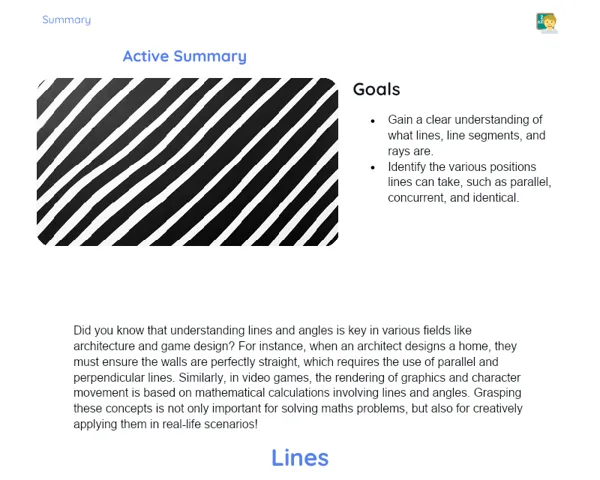Summary Tradisional | Trigonometric Lines of 75º, 15º, 22.5º
Contextualization
Trigonometry has been a cornerstone of mathematics for centuries, finding its place in various practical fields like engineering, physics, and architecture. Angles such as 75°, 15°, and 22.5° are particularly valuable for precision tasks, from the design of intricate buildings to navigation and astronomy. A solid grasp of the trigonometric functions of these angles can significantly enhance problem-solving skills and sharpen mathematical thinking.
The angles of 75°, 15°, and 22.5° come with unique trigonometric characteristics that can be derived using sum and difference formulas along with the half-angle formula. These tools are essential in deriving the sine and cosine of these angles. For instance, in astronomy, these specific angles help locate celestial bodies, while engineers rely on these calculations in building design. Thus, mastering these trigonometric properties is vital for real-world applications.
To Remember!
Trigonometric Functions of 75°
To determine the trigonometric functions of 75°, we apply the angle sum formula. Specifically, 75° can be expressed as the sum of 45° and 30°. The relevant formulas are:
Sine: (\sin(75°) = \sin(45° + 30°) = \sin 45° \cos 30° + \cos 45° \sin 30°) Cosine: (\cos(75°) = \cos(45° + 30°) = \cos 45° \cos 30° - \sin 45° \sin 30°)
By substituting the known values of the trigonometric functions for 45° and 30°, we compute:
(\sin 75° = \left( \frac{\sqrt{2}}{2} \right) \left( \frac{\sqrt{3}}{2} \right) + \left( \frac{\sqrt{2}}{2} \right) \left( \frac{1}{2} \right) = \frac{\sqrt{6}}{4} + \frac{\sqrt{2}}{4} = \frac{\sqrt{6} + \sqrt{2}}{4}) (\cos 75° = \left( \frac{\sqrt{2}}{2} \right) \left( \frac{\sqrt{3}}{2} \right) - \left( \frac{\sqrt{2}}{2} \right) \left( \frac{1}{2} \right) = \frac{\sqrt{6}}{4} - \frac{\sqrt{2}}{4} = \frac{\sqrt{6} - \sqrt{2}}{4})
This approach simplifies our calculations by breaking down 75° into 45° and 30°, which allows us to directly apply the sum formulas for accurate results.
-
75° can be expressed as 45° + 30°.
-
We calculate sine and cosine using the angle sum formula.
-
Final results are acquired by substituting known trigonometric values.
Trigonometric Functions of 15°
For 15°, we'll use the angle difference formula. Here, 15° can be broken down into 45° - 30°. The formulas we apply are:
Sine: (\sin(15°) = \sin(45° - 30°) = \sin 45° \cos 30° - \cos 45° \sin 30°) Cosine: (\cos(15°) = \cos(45° - 30°) = \cos 45° \cos 30° + \sin 45° \sin 30°)
Once we substitute the known values for 45° and 30°, we find:
(\sin 15° = \left( \frac{\sqrt{2}}{2} \right) \left( \frac{\sqrt{3}}{2} \right) - \left( \frac{\sqrt{2}}{2} \right) \left( \frac{1}{2} \right) = \frac{\sqrt{6}}{4} - \frac{\sqrt{2}}{4} = \frac{\sqrt{6} - \sqrt{2}}{4}) (\cos 15° = \left( \frac{\sqrt{2}}{2} \right) \left( \frac{\sqrt{3}}{2} \right) + \left( \frac{\sqrt{2}}{2} \right) \left( \frac{1}{2} \right) = \frac{\sqrt{6}}{4} + \frac{\sqrt{2}}{4} = \frac{\sqrt{6} + \sqrt{2}}{4})
Decomposing 15° this way allows us to directly apply the difference formulas and find the precise trigonometric functions.
-
15° can be broken down into 45° - 30°.
-
We use the angle difference formula for sine and cosine calculations.
-
Final values come from substituting known trigonometric functions.
Trigonometric Functions of 22.5°
For the half-angle of 22.5°, we apply the half-angle formula since it can be expressed as half of 45°. The formulas are:
Sine: (\sin(22.5°) = \sin \left( \frac{45°}{2} \right) = \sqrt{\frac{1 - \cos 45°}{2}}) Cosine: (\cos(22.5°) = \cos \left( \frac{45°}{2} \right) = \sqrt{\frac{1 + \cos 45°}{2}})
Since 22.5° is in the first quadrant, we consider only the positive root. Substituting the known trigonometric values for 45°, we get:
(\sin 22.5° = \sqrt{\frac{1 - \frac{\sqrt{2}}{2}}{2}} = \sqrt{\frac{2 - \sqrt{2}}{4}} = \frac{\sqrt{2 - \sqrt{2}}}{2}) (\cos 22.5° = \sqrt{\frac{1 + \frac{\sqrt{2}}{2}}{2}} = \sqrt{\frac{2 + \sqrt{2}}{4}} = \frac{\sqrt{2 + \sqrt{2}}}{2})
Using the half-angle formula simplifies our calculations, allowing for efficient acquisition of the trigonometric functions for 22.5°.
-
22.5° can be represented as half of 45°.
-
We apply the half-angle formula for sine and cosine calculations.
-
Final values are achieved through substituting known trigonometric functions.
Practical Applications of Trigonometric Functions
The trigonometric functions of 75°, 15°, and 22.5° have diverse applications across fields like engineering, physics, and architecture. For instance, in civil engineering, these angles are crucial in the design and construction of structures, such as bridges and buildings, where precise calculations are key to ensuring safety and stability.
In the realm of physics, these trigonometric functions factor into calculations related to waves and oscillatory phenomena, critical for developing systems with precise and controlled movements.
In architecture, these angles play a role in creating visually pleasing and functional elements like domes and arches, where mathematical precision is central to achieving both beauty and structural strength. Furthermore, in the world of computer graphics, 75°, 15°, and 22.5° angles are essential for rendering realistic three-dimensional models.
Grasping these trigonometric functions enables more efficient problem-solving in practical situations, allowing for the application of mathematical concepts in real-world scenarios and the development of innovative, safe solutions.
-
Used in civil engineering for structures' design and construction.
-
Applied in physics for calculations involving waves and oscillatory motions.
-
Important in architecture for creating aesthetic and functional designs.
-
Utilised in computer graphics for generating accurate 3D models.
Key Terms
-
Sine: A trigonometric function representing the ratio of the opposite side to the hypotenuse in a right triangle.
-
Cosine: A trigonometric function representing the ratio of the adjacent side to the hypotenuse in a right triangle.
-
Angle Sum: Formulas that allow the calculation of the functions of an angle formed by the sum of two other angles.
-
Angle Difference: Formulas that enable the calculation of the functions of an angle formed by the difference of two angles.
-
Half-Angle: Formulas used to compute functions of an angle that is half of another angle.
-
Trigonometry: A branch of mathematics studying the relationships between the angles and sides of triangles.
-
Trigonometric Functions: The values of sine and cosine for specific angles.
Important Conclusions
In this lesson, we delved into the trigonometric functions of the angles 75°, 15°, and 22.5° using the angle sum, angle difference, and half-angle formulas correspondingly. We learned to calculate the sine and cosine of these angles precisely, an essential skill for tackling complex mathematical problems.
We highlighted various practical applications of these functions across fields like engineering, physics, architecture, and computer graphics. Recognising these applications helps us appreciate the relevance of the subject and encourages a deeper engagement with the material.
Finally, we underscore the importance of mastering these mathematical tools to nurture sharp logical reasoning and to apply them effectively in real scenarios, whether in academic contexts or in professional environments.
Study Tips
-
Review the formulas for angle sum, angle difference, and half-angle, practising with a variety of examples.
-
Seek out additional resources like videos and online exercises to visualise and comprehend the practical applications of trigonometric functions.
-
Form study groups to discuss and collaboratively solve practical problems involving the trigonometric functions of 75°, 15°, and 22.5°, sharing insights and strategies.



